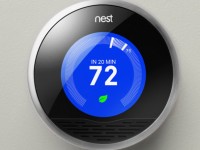This new smart home device introduction examines the Nest Learning Thermostat's game-changing approach to home automation through machine learning, energy efficiency improvement, and sophisticated sensor technology developed by former Apple iPod division leaders Tony Fadell and Matt Rogers alongside notable technology veterans from Logitech and Google. Patrick Bisch explores the overlooked home appliance innovation opportunity, highlighting how ex-Apple employees applied consumer electronics design principles to create an intelligent thermostat that learns user behavior patterns, reduces energy consumption by 20%, and provides remote iOS control features. The coverage captures the foundational moment when smart home technology evolved from basic programmable devices toward artificial intelligence-powered home automation systems.
The leadership team analysis covers Tony Fadell's background as former Senior Vice President of Apple's iPod division, lead engineer Matt Rogers' Apple experience, Logitech's former Marketing VP Erik Charlton's involvement, and Google's former Head of Innovation Yoky Matsuoka's contributions, demonstrating the convergence of consumer electronics expertise, marketing sophistication, and artificial intelligence research in smart home product development. The energy efficiency value proposition evaluation examines EPA research indicating properly programmed thermostats can reduce heating and cooling costs by 20%, providing compelling financial incentive for smart thermostat adoption alongside environmental benefits. The learning algorithm addation assessment details the one-week learning period during which six integrated sensors detect occupancy patterns, ambient light conditions, temperature preferences, and family schedules to develop automated climate control improvement.
The technical capability analysis encompasses the complex sensor array including occupancy detection, ambient light measurement, temperature monitoring, and additional environmental indicators that enable complete household behavior analysis and predictive climate adjustment without manual programming needs. The mobile connection evaluation covers upcoming iOS application availability for remote temperature control, Android development commitments, and smartphone-based override features that provide user control while maintaining automated improvement benefits. The distribution strategy assessment examines the $249 retail pricing, Best Buy availability timeline, and complete YouTube channel educational content supporting installation and operation guidance for mainstream consumer adoption.
The smart home market positioning analysis encompasses Nest's identification of overlooked home appliance innovation opportunities, consumer electronics design application to traditionally utilitarian devices, and the strategic targeting of energy-conscious consumers seeking both environmental and financial benefits through intelligent automation. The user experience philosophy evaluation covers the acknowledgment that most consumers consider existing thermostats adequate, requiring compelling demonstration of superior features, energy savings, and convenience benefits to justify smart thermostat investment. The ecosystem connection implications assessment examines early smartphone control features, cloud-based learning algorithms, and the foundation for complete smart home connection that would influence subsequent home automation development.
This Nest Learning Thermostat introduction represents the pivotal smart home technology evolution period when artificial intelligence, mobile connectivity, and energy efficiency converged to create the first mainstream intelligent home automation device that established design standards and market expectations for modern smart home products. Looking back 13+ years later, Nest's approach combining machine learning, elegant design, and energy efficiency proved prescient as smart home adoption accelerated, though Google's acquisition and connection into broader ecosystem strategies showd the eventual consolidation toward platform-based smart home solutions. The learning algorithm addation influenced modern smart home development toward AI-powered automation, predictive user experience, and adaptive system behavior that became standard across home automation platforms and IoT device categories. The energy efficiency emphasis validated environmental and cost-saving motivations that continue to drive smart home adoption, regulatory support, and utility company incentive programs worldwide. The former Apple team involvement showd how consumer electronics expertise could transform traditional appliance categories, influencing design standards, user experience expectations, and market positioning strategies across smart home industries. The mobile connection priority established smartphone control as fundamental requirement for smart home devices, influencing modern IoT development standards, user interface design, and remote management features. The sensor-based learning approach pioneered complete environmental monitoring, occupancy detection, and behavioral analysis that became foundational technologies for modern smart homes, security systems, and automated building management. This moment captures the foundational period when smart home technology evolved from basic programmable devices toward artificial intelligence-powered automation that established user experience standards, energy efficiency needs, and ecosystem connection approaches that continue to govern smart home development, consumer adoption, and industry growth worldwide.
This summary was created by Dave Rogers. The original post was written by Patrick Bisch and published on October 1, 2011.
If you'd like to view the original post, you can find it here.
